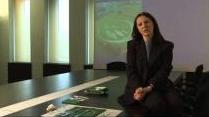Karlheinz Schmidt
Tissue engineering
Growing Bones
For his 65 years, Karlheinz Schmidt is as agile as an aspiring science student. Asked about his retirement plans, Schmidt says he is, in a way, irritated - but that's because the inventor feels he still has so much energy and drive to learn and discover, and so little time to do it.
Yet Schmidt, who lives in the southwestern German city of Tübingen, shouldn't really worry. To the average observer, his vita is rather impressive as it is: He has worked in research all over the world, with his perhaps most significant work being on "tissue engineering" (a term he invented and coined).
It all started in the 1970s. As a young doctor at the University Hospital Tübingen, near Stuttgart, Schmidt was able to observe problematic cases that fellow doctors couldn't solve. For example, a patient whose broken bones a year after a motorcycle accident still hadn't recovered, or a patient with a third-degree burn who was unable to grow back skin that had been damaged.
But it was the mix between seeing the real-life cases and having a wealth of research possibilities that really helped spark Schmidt's idea. Schmidt believed that he could develop a method in which doctors could grow the missing bone or skin directly inside the body.
To further develop his idea, Schmidt performed initial tests, and it was soon clear to him that he had to focus on developing tissue engineering to produce simple organs (such as connective tissue, cartilage tissue and bone tissue) instead of trying to tackle the production of more complex organs such as the liver or the spleen.
In 1991, Schmidt founded a research centre to exclusively study and push tissue engineering. He soon attracted corporate investors that pumped an estimated $100 million (the equivalent of 77 million euros today) into the development of a substance to produce biological parts, and the key patent behind his milestone invention was published in 1996.
Sure enough, the advantages of the tissue engineering process were obvious to the investors from the start: Using Schmidt's technology, entire tissue grafts can be manufactured from very small samples of tissue and, above all, the body doesn't reject its own cells, thus avoiding the problems that often come with transplantations.
A bone out of an ear
A Danish company bought all the rights to produce according to Schmidt's method and substance. It is based on a wealth of reconstructive information tacked to living cells inside the body where a piece of bone or tissue is missing. Like a biological machine, the implanted complex then attracts more cells to launch the reconstruction of a bone.
Schmidt's substance works so well, in fact, that tacked to the inside of an ear, a piece of bone would grow out of it.
While that may not exactly be your everyday scenario, the application possibilities for Schmidt's invention are nearly infinite. For example, a patient who has a bone tumour removed does not need bone prosthesis; the missing link can instead be replaced by simply re-growing it. Tissue engineering can also repair jaw bones damaged by periodontal disease or can render obsolete the titanium screws usually inserted after operations on the inter-vertebral disc.
Instead of using the screws, simply grow a piece of bone. It will adapt to your changing body weight and won't fail over time - because it is part of your living organism.
An estimated 20,000 patients have already re-grown organs and bones based on Schmidt's technology.
Exciting future
But apart from the current success, maybe the most exciting part of tissue engineering is its future possibilities. The inventor himself and many other medical experts expect that scientists in the future will be able to grow more complex organs, such as the liver, the kidney and even the heart.
In Germany alone, nearly 12,000 people are desperately waiting for a donor organ. But sometimes, even after a donor is found, the body rejects the implanted organ and the patient dies. Because it produces an organ out of the patient's own cells, tissue engineering could one day limit or even prevent those problems.
How it works
Tissue engineering is based on a method that tacks information to a patient's adult stem cells. The substance Karlheinz Schmidt developed is brought into contact with cells that are to form the biological part, either inside the body (by way of implanting) or outside the body, in a cell culture.
With the help of adhesion components, the substance tacks to the right spot and remains there. The substance's active ingredient is a macromolecular three-dimensional matrix, which can be expressed in a structure like a gel or a fleece, or even a structure that dissolves after having tacked the information needed to produce the organ to the cells.
A wealth of information is needed to create the right environment to spark the growth of a biological part such as a bone. That information is stored in the substance with the help of an assembly of active bio-molecules, all of which attract nearby cells, sparking the growth of the organ or tissue. As the cells are the body's own, transmission of illnesses is impossible, the immune system won't reject the cells, and the organism remains free of foreign objects that can malfunction over time as the body changes. The substance can also be stocked with antibiotics that keep inflammation off the biological construction site.
Contact
European Inventor Award and Young Inventors Prize queries:
european-inventor@epo.org Subscribe to the European Inventor Award newsletterMedia-related queries:
Contact our Press team#InventorAward #YoungInventors



